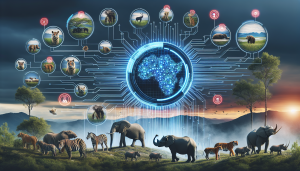 UseCasesFor.ai
UseCasesFor.ai
Choose Topic
 UseCasesFor.ai
UseCasesFor.ai
AI Use Cases
A collection of over 250 uses for artificial intelligence
A continually updated list exploring how different types of AI are used across various industries and AI disciplines,including generative AI use cases, banking AI use cases, AI use cases in healthcare, AI use cases in government, AI use cases in insurance, and more

Sign up
to receive a PDF containing all the use cases and stay updated with the latest AI trends and news (you can always unsubscribe)
Poaching prevention

Introduction
Poaching in the wildlife industry is one of the biggest threats that has posed a great threat to the world’s biodiversity. This includes elephants and rhinos, tigers, and pangolins among others that are being hunted illegally for their body parts and has led many of these animals to the edge of extinction. However, in the recent years, there have been some advancements in the artificial intelligence (AI) technologies such as computer vision (CV) and machine learning (ML) that has presented a new way to address this problem. These technologies that are being developed are now being applied in the detection, prediction, and prevention of poaching activities in the real time, thus, giving a beam of light to the efforts of saving the world’s wildlife.
Challenges
There are various difficulties in the fight against poaching and they are not easy to overcome. Another challenge is the fact that most natural habitats are large and difficult to patrol hence making it hard to detect poaching activities easily. Another factor that compounds this challenge is the scarcity of resources such as finance and personnel. Another problem is that poaching syndicates are also becoming more organized; some of them are even employing technology to avoid being caught. Also, the diversity of species and the variety of ways that each species is poached makes it very difficult to find a general approach. Lastly, the problem of compiling and analyzing big data on poaching activities and predicting their further development is the issue of skill and capacity.
AI Solutions
There are several challenges that affect the effective monitoring of poaching activities and protecting the endangered species and AI, particularly CV and ML, provide befitting answers to these challenges. CV algorithms can review footage from drones or trail cameras to recognize possible poachers and the algorithms can do so even in low light or in not so ideal weather conditions. ML models can process large amount of data that has been compiled on previous poaching activities and animal movements to identify the areas which are most likely to witness poaching. One such example is the PAWS (Protection Assistant for Wildlife Security) project which was developed by the University of Southern California and is based on ML to identify hotspots of poaching. The application of artificial intelligence is not only limited to traditional machine learning but to autonomous systems as well. For example, the Air Shepherd, a non-profit organization employs unmanned aerial vehicles (UAVs) equipped with artificial intelligence, machine learning, computer vision, and infrared cameras to conduct patrols of wildlife conservation areas in search of poachers especially at night. Also, there are other forms of AI cameras such as the ‘smart’ cameras that Resolve’s TrailGuard AI project has come up with; these cameras are capable of differentiating between human and animal, and only raise an alarm when necessary, minimizing false alarms and hence efficient use of resources.
Benefits
There are so many advantages of using AI in the fight against poaching that it would be foolish not to consider it as a tool in the fight against poaching. This is because AI can help enhance the efficiency and the effectiveness of the anti-poaching measures that are undertaken without necessarily having to rely on many people to carry out the patrols and also enable the authorities to take action before the crime is even committed. It also minimises the risk to rangers who are often exposed to threats in the course of their work. In addition, AI is capable of processing large amount of data within the shortest time and with a high level of precision to identify poaching activities. This can result to proper utilization of resources and hence protect more animals. It also forms a good basis for research and conservation planning. Last but not the least, the application of AI technologies can discourage the would-be poachers because they know that they will be caught.
Return on Investment
It can be seen that the ROI of applying AI in poaching prevention can be very high. Although there is a significant expense that has to be incurred when setting up AI technology, the costs in terms of manpower, resources and most importantly the cost of not losing wildlife are minimal. There is no doubt that the more these technologies are used, the more affordable they will be, which makes them even more economical. Also, the information collected from such systems is a great asset to any further conservation and research plans. Therefore, the ROI should not only be seen in terms of the financial return but also in terms of conservation of species and even the return of some species that are on the brink of extinction.